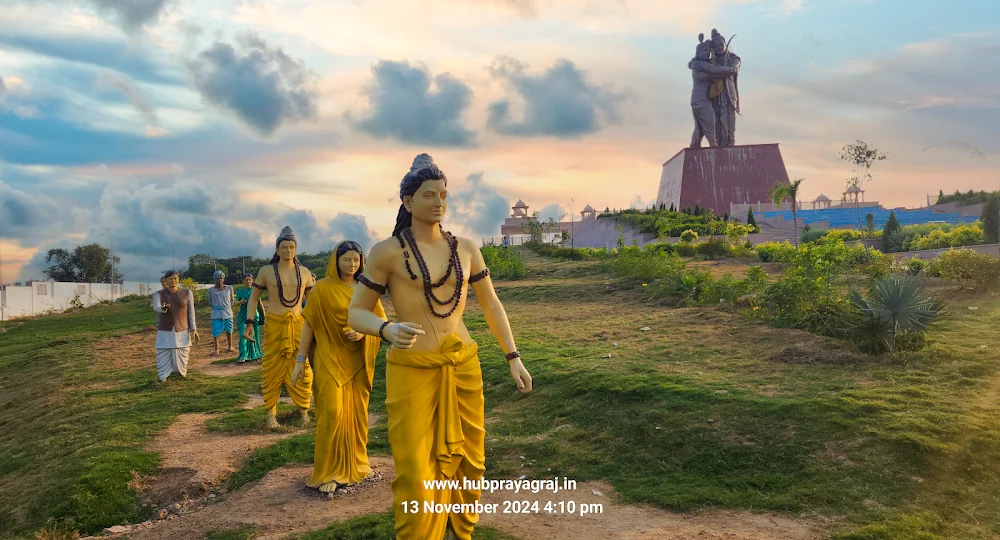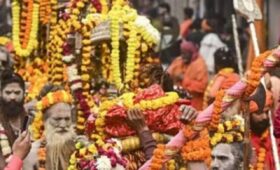Shakti Peeth – Vindhyachal
The temple of Goddess Vindhyavasini, located in Mirzapur, is one of the 51 Shakti Peeths in India. Legend has it that the goddess herself manifested in physical form here, on the Vindhya Mountains. Goddess Vindhyavasini is worshipped here in her three forms-Mahalakshmi, Mahakali, and Mahasaraswati-which is why this place is often referred to as the triangle of the supreme powers. About 80 km from the Prayagraj headquarters and
90 km from Varanasi, the Vindhyachal Mountains are not only a site of extraordinary natural beauty but also a place of deep cultural significance. The hills echo with the melodious flow of the holy Ganges, offering a unique glimpse of nature’s splendor. Every year, during the Navratri festival in March-April and September-October, a nine-day fair is held here, where devotees worship and seek blessings from the goddess. Special rituals and aarti are performed at the temple.
Ramayana Circuit
Ramayana Circuit
The Ramayana Circuit offers a unique spiritual journey through locations of immense significance in Hindu mythology. From Lord Ram’s birthplace in Ayodhya to the serene forests of Chitrakoot, each site provides a glimpse into the epic tale of the Ramayana, making it a must-see for devotees and history enthusiasts alike. Significant locations in the Ramayana Circuit within Uttar Pradesh include Ayodhya, Shringverpur. Prayagraj, and Chitrakoot. These sites are believed to be linked to the life and times of Lord Ram. Born in Ayodhya as the son of King Dasharath, Lord Ram was sent into exile for 14 years at the behest of his stepmother Kaikeyi. During their exile, Lord Ram, along with his wife Sita and brother Lakshman, journeyed through Shringverpur and Prayagraj on their way to Chitrakoot.
Ayodhya Dham
Ayodhya Dham
Ayodhya, counted among the seven most sacred cities of ancient India, is situated on the banks of the ancient Sarayu River. As the former capital of the Awadh region, Ayodhya holds a special place for devotees as the birthplace of Lord Shri Ram. According to the Atharvaveda, the city was built by the gods themselves. Ayodhya served as the capital of the Kingdom of Kosala for centuries, ruled by great kings such as Ikshvaku, Prithu, Mandhata, Harishchandra, Sagara, Bhagirath, Raghu, Dilip, Dasharath, and Shri Ram. Under their reign, the kingdom flourished, reaching its peak during the era of Ram Rajya, which became a symbol of prosperity and justice. The grandeur of Ayodhya is beautifully depicted in the famous epics Ramayana and Shri Ramcharitmanas.
Main Attractions
Ramkot, Treta Ke Thakur, Ram Ki Paidi, Nandigram (Bharat Kund), Mani Parvat, Ram Katha Museum, Tulsi Smarak Bhawan, and Choti Devkali Temple
Chitrakoot
Chitrakoot
Chitrakoot, a famous pilgrimage site, renowned for its connection to the epic Ramayana and serves as a prominent center for spiritual seekers This is the place where Lord Ram and Goddess Sita spent nearly 12 years of their exile and where Sage Atri and his wife, Sati Anusuya, meditated. Nestled in the forests along the banks of the Mandakini River (also known as Payaswini), Chitrakoot straddles the borders of Uttar Pradesh and Madhya Pradesh. The town is adorned with numerous temples along the riverbanks, each telling its own story from ancient times. Each site in the Ramayana Circuit is well connected by road and offers a unique blend of spirituality, history, and culture, making a journey through the Ramayana Circuit an unforgettable experience. Ayodhya is approximately 170 km from Shringverpur, Shringverpur is about 40 km from Prayagraj, and Prayagraj is roughly 130 km from Chitrakoot
Varanasi
Varanasi
Varanasi, located 120 km from Prayagraj, is one of the world’s oldest continuously inhabited cities. Also known as Kashi and Banaras, it is a major religious center for Hindus, Buddhists, and Jains. The city’s prominent tourist attractions include The famous Kashi Vishwanath Temple, 8 ghats along the Ganges River, Sarnath, and many other significant temples dedicated to Hinduism and jinism. For thousands of years, Varanasi has been the cultural and religious heart of India, especially North India The Banaras Gharana of Hindustani classical music originated and flourished here. Many of India’s greatest philosophers, poets, writers, and musicians, including Kabir, Vallabhacharya, Ravidas, Swami Ramanand, Trailinga Swami, Shivanand Goswami, Munshi Premchand, Jaishankar Prasad, Acharya Ramchandra Shukla, Pandit Ravi Shankar, Girija Devi, Pandit Hariprasad Chaurasia, and Ustad Bismillah Khan, have lived in Varanasi. It was here that Goswami Tulsidas composed the epic Ramcharitmanas, and where Gautama Buddha gave his first sermon at nearby Sarnath. Varanasi is also home to four major universities: Banaras Hindu University, Mahatma Gandhi Kashi Vidyapeeth, Central Institute of Higher Tibetan Studies, and Sampurnanand Sanskrit University




